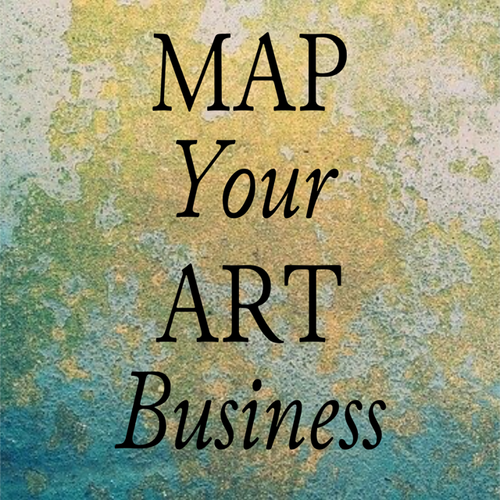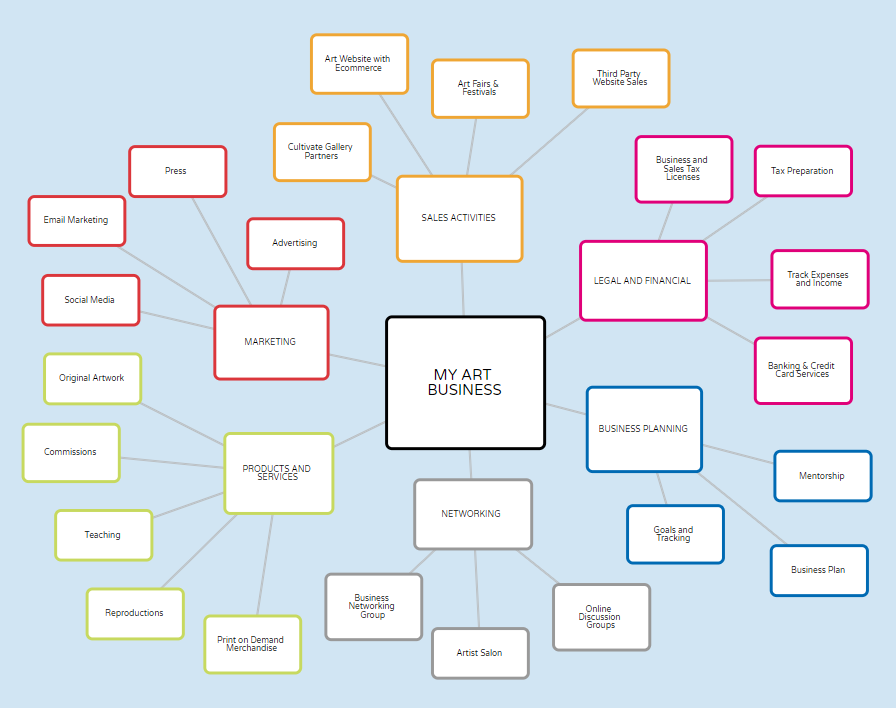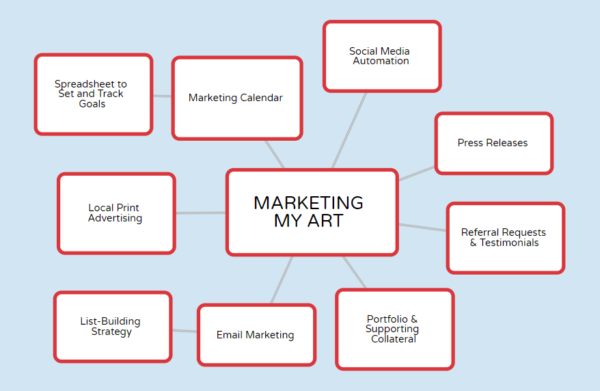by Carolyn Edlund
Here’s a method of big picture planning to guide you in building your art business.

An interviewer recently asked my opinion of the biggest mistake artists make in business. There may be endless answers to that question, but it wasn’t hard to pinpoint a major issue that I often see. As a business consultant, I have deep conversations with people interested in working full-time as an artist. And as a speaker on art business topics, I frequently converse with large groups of artists who want to earn a living doing what they love.
In my experience, a major misconception is the amount of planning and work involved in running an art business. Many people believe that “if you build it, they will come” which couldn’t be farther from the truth. Customers do not materialize out of thin air. Having an artist website does not guarantee that anyone will visit. It is unrealistic to believe that some sort of agent will show up to manage your business and make sales, leaving you to work in the studio. Instead, you as the artist must act as the CEO of your business to plan, make decisions and take action to get results.
Specific action and hard work
Many new entrepreneurs don’t truly understand the complexity involved in starting and structuring a business to be sustainable. What does that mean? A sustainable business is built to last; it runs like an engine, moving you forward and growing over time. Different parts of the business work together seamlessly, feeding into each other for the purpose of making sales and creating income streams. These functions are designed to be repeatable, through systems created for use on an ongoing basis.
Successful businesses don’t happen by accident. They are built quite deliberately, with thoughtful planning. That planning can be expressed visually, like a blueprint for a house. A mind map is a sort of blueprint for a business that you can create free using online tools. One main benefit of online mind maps is that they can be easily revised, expanded, copied and shared.

A mind map can encompass many aspects of a small business
Map it out
Above is a sample mind map of a fictitious artist business made using Popplet, an online mind map tool that contains many different working parts surrounding the main business concept. Each is crucial to starting a business and keeping it running.
Notice that each element of the business has equal “weight” on the mind map. None is more important; they are just different. You need to create in the studio and you need a marketing plan, but you also must sort out your finances and take care of legal considerations like registering your small business.
With a visual tool like this, you can focus on one area of your business without forgetting other parts that are necessary to the total structure. As an alternative to working with checklists that have a hierarchy of items (which you may never get through), mind maps lay everything out in front of you like an “exploded view” of your business with all the connections shown. Focus one area and go deeply into detail without losing sight of everything else that needs attention. Mind maps can be created at any scale, encompassing an overview of your whole business, or diving deeply into one area, such as marketing (example below).

Additional mind maps can become as detailed as needed
Make connections, then build systems
Get as granular as you need by building out your map in detail. Identify what you need to do to address each item on the map to make it function in your business. Then design systems that support each other and your business as a whole. Examples of different systems you might create are:
- Email templates to be reused in a monthly eblast
- Form letters with vital information that can be customized
- Customer relationship management (CRM) tools to handle prospects, follow ups and sales
- An organized portfolio and supporting collateral that is regularly updated
- Financial data stored in one place with accessible reports
- Social media messaging and posting schedule
- Schedule for upcoming new releases
- Production calendar to make and ship orders
Sustainability means leveraging your efforts to plan and build systems once, then using them again and again. Over time you can measure their effectiveness and make adjustments to keep your art business running like a well-oiled machine. As you see results, this puts you in a position to double down on what works and make the most of every opportunity!


Hi Carolyn, and thank you for this very accurate reminder of the ever-changing work involved in developing a business.
And indeed, one of the great strengths of Mind Mapping is that it maintains this level of movement (and thus energy) at each stage of development. Nothing is set in stone, and any activity is part of a wider ecosystem that is as much a source of risk as of opportunity.
So it is this ability to connect the dots that can make a real difference. And the more this vision is in motion, the more external questioning, communication and information gathering will be well directed.
There is nothing magical about it. It is all about putting our cognitive capacities in motion, in accordance with the principles of the human brain.
Thanks Denys, I also find that visual artists (being visual, of course) connect well with seeing everything laid out in front of them. The changeability of the project keeps it current and relevant.